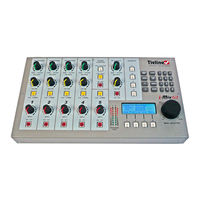User Manuals: Tieline i-Mix G3 IP Codec
Manuals and User Guides for Tieline i-Mix G3 IP Codec. We have 1 Tieline i-Mix G3 IP Codec manual available for free PDF download: Main Operation Manual
Tieline i-Mix G3 Main Operation Manual (355 pages)
TLM 600 Integrated Mixer-CODEC
Brand: Tieline
|
Category: Music Mixer
|
Size: 8 MB
Table of Contents
-
Page3
-
Page5
-
Page6
-
Page8
-
-
Controls14
-
Menu Text14
-
Hyperlinks14
-
-
Tool Box14
-
-
W Izards37
-
In Module44
-
-
-
C Onnecting70
-
Summary71
-
-
E Ncoder88
-
-
Clear96
-
Lcd Screen98
-
C Onnecting104
-
Summary114
-
Menu Settings115
-
Tool Box117
-
Setting 1122
-
Correction132
-
Rd Party Devices142
-
D Isplay146
-
-
Inputs153
-
Outputs153
-
Setup153
-
Dip Settings154
-
Piezo Alarm154
-
-
-
A Noverview172
-
-
Profile Editor182
-
User Profiles182
-
Figure 48: Thes183
-
Properties192
-
-
Connection Setup196
-
Settings199
-
Connection Type201
-
Mpeg Explained207
-
Samplerate214
-
Automatic Redial220
-
F Unction223
-
S Ettings226
-
Remote Profile228
-
Pots Tab229
-
Operating Mode230
-
Detect Dial Tone232
-
Monitor Enable232
-
Auto Answer233
-
Dial Method233
-
Leased Line233
-
Dial Pause Time234
-
Connections236
-
Gsm Connections236
-
Operating Mode237
-
-
Isdn Line Type243
-
Spid Explained243
-
Auto Answer245
-
Samplerate245
-
Isdn Tab241
-
-
X.21 Link Type247
-
Bit Rate248
-
Sample Rate248
-
-
Input Gains250
-
Input Types250
-
O Ptions251
-
Phantom Power252
-
Auxiliary Input256
-
-
Control Menu256
-
Commander G3 F259
-
Gang to Knob264
-
-
Ppm Displays265
-
Commander G266
-
Pa Controls267
-
Activation Rule273
-
Functions Tab271
-
User Function271
-
Type Menu284
-
-
Connection297
-
Edit Function303
-
Delete Function303
-
A Final Note304
-
-
Functions Menu289
-
-
Cue: an Overview308
-
Talkback311
-
Remote Cue312
-
Figure 89: Tb R312
-
-
Powerup Console317
-
Auto Reconnect318
-
Bonding Type318
-
-
Speed Dial319
-
Unit Lock319
-
Powerup Profile320
-
Serial Port Mode321
-
Serial Port Rate321
-
Name and Number323
-
-
C Hecklist329
-
Troubleshooting330
-
Troubleshooting331
-
Connectors339
-
Connector339
-
-
Fcc Part348
-
Fcc Part 68348
-
Appendix 4.3. IC349
-
-
Index352
Advertisement
Advertisement
